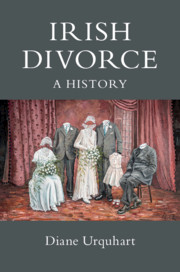Book contents
- Irish Divorce
- Irish Divorce
- Copyright page
- Dedication
- Contents
- Figures
- Acknowledgements
- Introduction: The ‘Anatomy of a Divorce’
- 1 Divorce in Two Legislatures: Irish Divorce, 1701–1857
- 2 The Failings of the Law: The Cases of Talbot and Westmeath
- 3 A Non-Inclusive Reform: Ireland and the Divorce and Matrimonial Causes Act of 1857
- 4 Divorce in the Post-Reform Era of 1857–1922: ‘Like Diamonds, Gambling, and Picture-Fancying, a Luxury of the Rich’
- 5 The Widening Definition of Marital Cruelty
- 6 Divorce in Court, 1857–1922
- 7 ‘An Exotic in Very Ungenial Soil’: Divorce in the Northern Ireland Parliament, 1921–1939
- 8 With as ‘Little Provocation as Possible’: The Northern Ireland Move to Court
- 9 An ‘Unhappy Affair’: Divorce in Independent Ireland, 1922–1950
- 10 Marriage Law ‘in This Country Is an Absolute Shambles’: The Reform Agenda
- 11 A ‘Curiosity [and] … an Oddity’: Referenda in 1986 and 1995
- 12 The ‘Last Stretch of a Long Road’: The Family (Divorce) Law Act of 1996
- Conclusion
- Bibliography
- Index
6 - Divorce in Court, 1857–1922
Published online by Cambridge University Press: 16 January 2020
- Irish Divorce
- Irish Divorce
- Copyright page
- Dedication
- Contents
- Figures
- Acknowledgements
- Introduction: The ‘Anatomy of a Divorce’
- 1 Divorce in Two Legislatures: Irish Divorce, 1701–1857
- 2 The Failings of the Law: The Cases of Talbot and Westmeath
- 3 A Non-Inclusive Reform: Ireland and the Divorce and Matrimonial Causes Act of 1857
- 4 Divorce in the Post-Reform Era of 1857–1922: ‘Like Diamonds, Gambling, and Picture-Fancying, a Luxury of the Rich’
- 5 The Widening Definition of Marital Cruelty
- 6 Divorce in Court, 1857–1922
- 7 ‘An Exotic in Very Ungenial Soil’: Divorce in the Northern Ireland Parliament, 1921–1939
- 8 With as ‘Little Provocation as Possible’: The Northern Ireland Move to Court
- 9 An ‘Unhappy Affair’: Divorce in Independent Ireland, 1922–1950
- 10 Marriage Law ‘in This Country Is an Absolute Shambles’: The Reform Agenda
- 11 A ‘Curiosity [and] … an Oddity’: Referenda in 1986 and 1995
- 12 The ‘Last Stretch of a Long Road’: The Family (Divorce) Law Act of 1996
- Conclusion
- Bibliography
- Index
Summary
Those of Irish domicile or lacking a permanent home in England or Wales were barred from the divorce court, but parliamentary divorce’s noxious reputation encouraged some Irish petitioners to develop means to circumvent its expense and publicity. Various strategies such as renting a house and paying rates in England were deployed to access the divorce court. This chapter samples Irish petitioners who divorced in court both legally and surreptitiously. A covert court divorce could invalidate second marriages, bastardise issue and contest marriage settlements. The late-nineteenth-century court-based divorces of domiciled Irishmen Colonel Sinclair and Colonel Malone were the most widely publicised of these cases. The legitimacy of their divorces was questioned, and problems arose regarding marriage settlements. The court was therefore increasingly rigorous about testing domicile; a rule that all divorce court petitioners would have to swear English domicile and falsification would bar the proceedings was introduced. However, although domicile was more stringently tested, Irish cases were presented to the divorce court with an increased regularity in the early twentieth century.
Keywords
- Type
- Chapter
- Information
- Irish DivorceA History, pp. 123 - 130Publisher: Cambridge University PressPrint publication year: 2020



